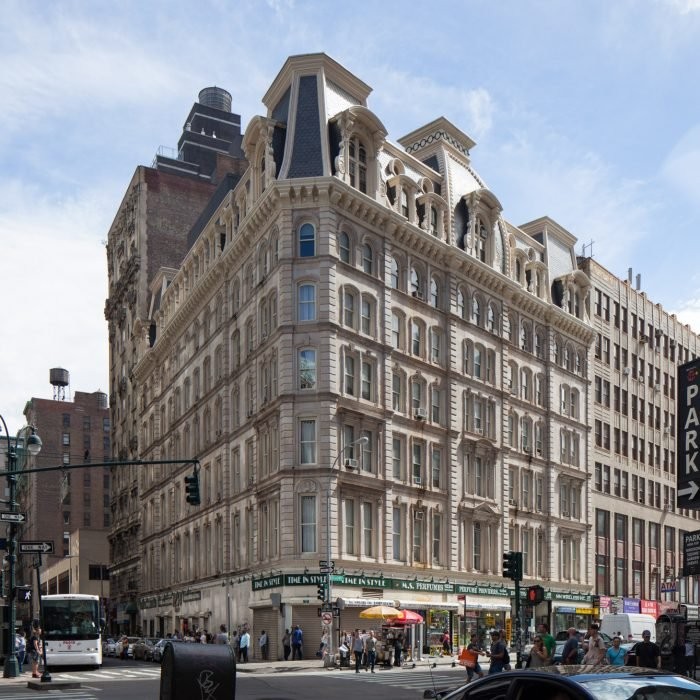Grand Hotel
Introduction
Text-to-speech Audio
In the years following the Civil War, the areas along Broadway and Fifth Avenue became home to numerous fashionable businesses and residences. One of those was the Grand Hotel, which was commissioned by Elias Higgins in 1868. Higgins was a successful carpet manufacturer who expanded into real estate, often building impressively elegant structures. As its name suggests, the Grand Hotel was an opulent white marble structure. As the theater district shifted northward, new luxury hotels and theaters were built beyond this neighborhood. By the turn of the century, Times Square became the location of the city's leading hotels and the Grand Hotel became something less worthy of its moniker as vice-filled what was then known as the Tenderloin District. Thanks to preservationists, the building once again offers a grand facade and has been listed on the National Register of Historic Places since 1979.
Images
The Grand Hotel stands as a reminder of the time when this part of the city was home to theaters and luxury hotels.

Backstory and Context
Text-to-speech Audio
In 1868, Broadway was just beginning its transformation into the neon-lit entertainment center that it would become. It was a time when well-heeled New Yorkers were slowly moving northward toward Madison Square, and businesses, hotels, and residences followed suit. Elias Higgins, a carpet manufacturer who made a fortune and then expanded into real estate development, was prescient when he decided to build an elegant new hotel at this location on Broadway. Higgins worked with architect Henry Engelbert, with whom he would collaborate on numerous buildings in the city, including the Grand Central Hotel.
The Grand Hotel was built in the French Second Empire style and included a total of eight stories, including two inside the mansard roof. Like many of the Paris apartments it emulates, the building features a cast iron ground floor with large windows.
Higgins planned for the building to be a residential hotel. Consequently, the hotel was built without kitchens or dining rooms, as residents would eat in a communal dining room. Later, as the theater district moved closer to Times Square, it made economic sense to convert the property into a traditional hotel with a restaurant.
Over the course of the twentieth century, the hotel and the building's fortunes declined. By the 1980s, the building was a single occupancy hotel whose owners painted over the marble facade in violation of landmark laws. The ground floor was divided into leasable storefronts in the 1950s. In recent years, preservationists were able to remove the paint without damaging the marble and significant restoration work has helped to preserve the building's facade.
The Grand Hotel was built in the French Second Empire style and included a total of eight stories, including two inside the mansard roof. Like many of the Paris apartments it emulates, the building features a cast iron ground floor with large windows.
Higgins planned for the building to be a residential hotel. Consequently, the hotel was built without kitchens or dining rooms, as residents would eat in a communal dining room. Later, as the theater district moved closer to Times Square, it made economic sense to convert the property into a traditional hotel with a restaurant.
Over the course of the twentieth century, the hotel and the building's fortunes declined. By the 1980s, the building was a single occupancy hotel whose owners painted over the marble facade in violation of landmark laws. The ground floor was divided into leasable storefronts in the 1950s. In recent years, preservationists were able to remove the paint without damaging the marble and significant restoration work has helped to preserve the building's facade.
Sources
The 1868 Grand Hotel--Broadway and 31st Street. Daytonian in Manhattan. July 03, 2010. Accessed June 23, 2019. https://daytoninmanhattan.blogspot.com/2010/07/1868-grand-hotel-broadway-and-31st.html.
The Grand Hotel, Gilsey House, and the Evolution of Broadway. Curbed New York. April 19, 2013. Accessed June 23, 2019. https://ny.curbed.com/2013/4/19/10252186/the-grand-hotel-gilsey-house-and-the-evolution-of-broadway.
The Grand Hotel, Gilsey House, and the Evolution of Broadway. Curbed New York. April 19, 2013. Accessed June 23, 2019. https://ny.curbed.com/2013/4/19/10252186/the-grand-hotel-gilsey-house-and-the-evolution-of-broadway.
